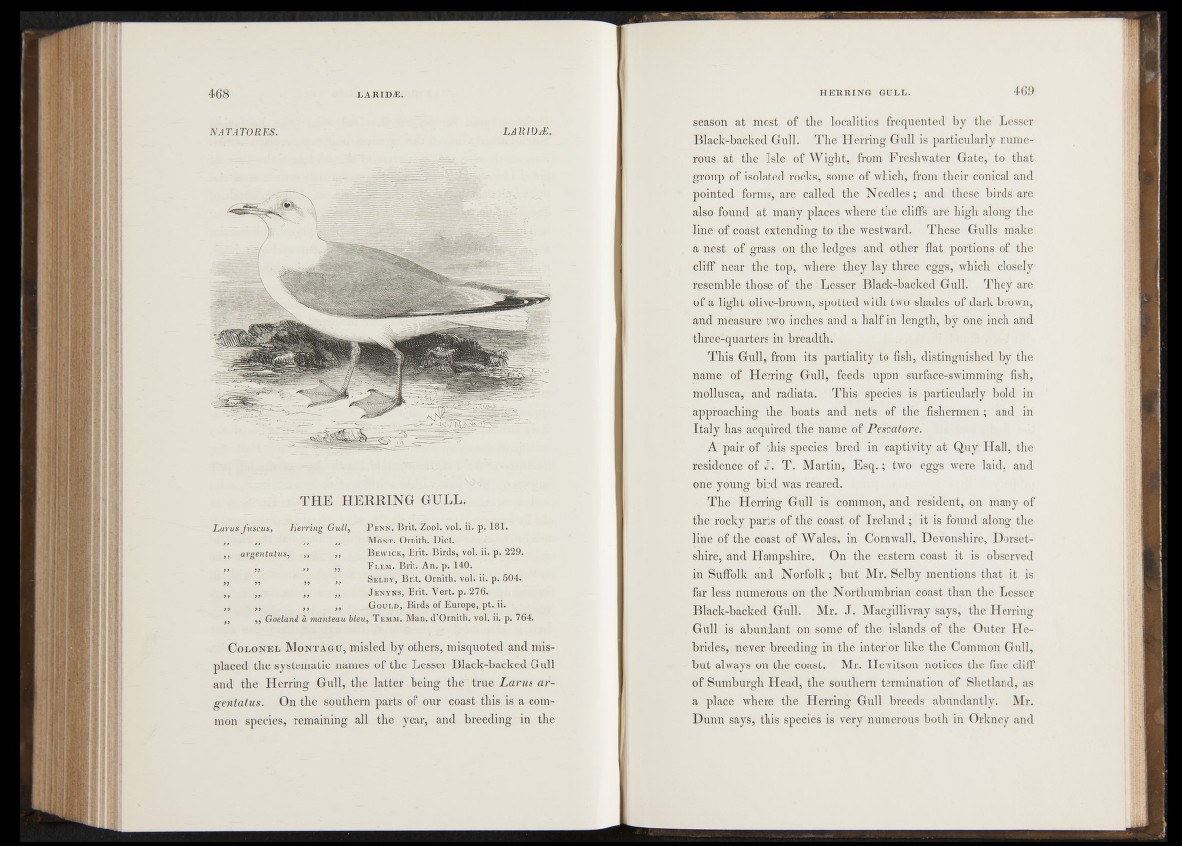
NATATORES. LARIDÆ.
T H E H E R R IN G GULL.
Larus fuscus, ~ Herring GuÙ^l_ P en§7 pî'I’é li
MôStV. Ornitlu 0icV* :
- ,, , -Bev^MRvjJkit, Birds, vol. ii.^p. 2-29. ^
FLEBirfeit.'An. p.1 4 0 .
' - Sélby,B rit. OrSÜiffŸdw^ü. p< S^ü ^ " „ J enyns, Brit-. yeit. p.,27f$<„jj
Grvm.p.- Birds .ofjEurope, ,pt. in »
Goéland à manteau bleu, Temm. Man. dfflrniÆ vol.1 ii. p. 76$?
C o lo n e l M o n t a g u , misled by others, misquoted and misplaced
the systematic names of the Lesser Black-backed Gull
and the Herring Gull, the latter being tkC true Larus ar-
gentatus. - On the southern parts of. our coast this is a common
species, remaining all the year,, and breeding in the
season at most of the localities frequented by the Lesser
Black-backed Gull; The Herring Gull is particularly numerous.
at the- Isle of Wight, from Freshwater Gate, to that
group of isolated, rocks-, some of which, from their conical and.
pointed forms, are called the Needles ; and these birds are
also found afe many places where the cliffs’ are high along the
line' of-coast extending to^thei westward’. These Gulls make
a nest^of grass, on the ledges -and other flat portions of the
cliff hear the. -topj. where they.lay three eggs, which closely
resemble-,.those, of the - Lesser Black-backed Gull." They are
of a light olive-brown, spotted .with two* shades of dark brown,
and measure ty^d inches and a'half in length, by one inch and
three-quarters in breadth.
This Gull, from its partiality to fish, distinguished by the
name; of". Herring' Gull,' feeds ' upon surface-swimm ing fish,
molluscaj and' radiata. This- species is particularly bold in
approaching- the - boats and nets, of the . fishermen ; and in
Italy has acquired theKname of' Pescatore.\.
y~ AT pair of this species bred in captivity at Q,uy.Hall, the
residence of T. T. Martin, E sq .; two eggs were laid, and
on^-young - bird was feared. .
-1 The Herring "'Gull is common, and resident, on many of
th^pbdky'parts of the coast of Ireland; it is found along the
linMofWhefcoast of Wales, in Cornwall, Devonshire, Dorsetshire,
and Hampshire; On the-eastern coast it is observed
in>Suffolk and Norfolk; but1 Mr. Selby mentions that it is
far less-numerous on the Northumbrian coast than the Lesser
Black-backed’ Gull!. Mr.. J . . Macgillivray says,: the Herring•
Gi|Ib is abundant on some of the* islands of the Outer Hebrides,
never breeding in the interior like the. Common Gull,
but always bn the coast. Mr. Hewitson notices the fine cliff
of Sumburgh Head, the southern termination of Shetland, as
a place where the Herring Gull breeds abundantly. Mr.
Dunn says* this species is very numerous both in Orkney and